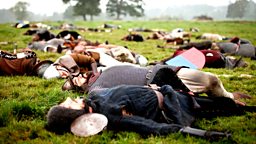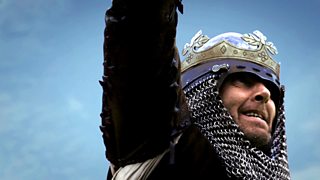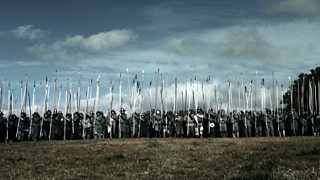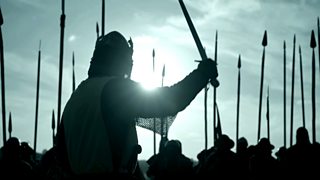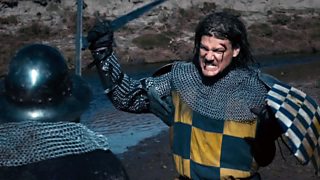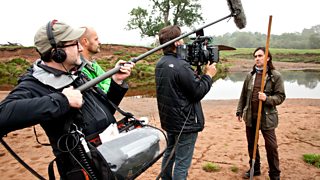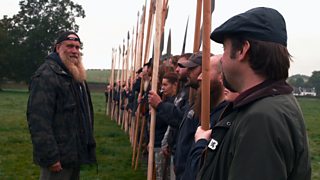Six defining moments in the battle that changed Scotland forever
The Quest for Bannockburn seeks to finally answer some of the questions that remain regarding and along the way we look at some of the key events that took place over those historic two days.
Together with the help of the these have been recaptured in glorious fashion to tell the story of Robert The Bruce's army of Scots taking on the much larger force of the English, lead by Edward II.
First blood (scene 1)
The English army arrived late afternoon on 23 June 1314.
A vanguard of English cavalry started to cross the Bannockburn and headed straight for Stirling Castle. At their head was a young knight Sir Henry de Bohun. He spotted the Bruce addressing his troops and decided to challenge the King of Scots.
A contemporary chronicle of the time, Barbour’s The Bruce describes what happened next;
“The gallant Sir Henry de Bohun knew the king by his arraying his men and reason of the crown on his basnet. When the Bruce saw him come on so openly before all his comrades he turned his horse towards him. And when Sir Henry saw the king come fearlessly on, he rode at him with the utmost speed. They dashed together in straight career, the Bruce with his keen strong axe dealt him such a mighty blow as neither hat nor helmet could withstand. The axe-handle shivered in two and De Bohun crashed helpless to the earth.”
The schiltrons stand firm (scene 2)
In anger the English cavalry twice charged the Scots schiltrons. These medieval hedgehogs were large groups of tightly packed men armed with spears. They formed a sort of tank, impenetrable by cavalry.
Barbour describes Bruce encouraging his men to stick to the plan, as long as they stayed together the schiltrons would stand firm against the English cavalry.
"Be not dismayed because of their din, but set your spears before you, and keep all back to back with the spear-points out.”
The combination of schiltrons and pits proved so impenetrable that on the second attack the English hurled their weapons at the Scots in frustration.
“Many spears, darts, knives, and weapons of all sorts were cast among the Scots, but they defended themselves so skilfully that the English were filled with wonder.”
Many spears, darts, knives, and weapons of all sorts were cast among the Scots, but they defended themselves so skilfully that the English were filled with wonder.
John Barbour
Morning prayers (scene 3)
After the disastrous events of the day one Edward II was forced to lead his men down onto a huge plain to the east; The Carse. This is where he decided to camp for the night. Day two of the battle started at first light.
While the English camp was still sleeping, the Scots crept silently down through Balquhidderrock wood. They emerged into the morning light and lined up.
To the astonishment of the sleepy English commanders the Scots kneeled down to pray. Across the Carse, Edward watched the scots kneeling. He took the Scots piety, as prayers for something else.
As Barbour describes; “The Scots all most devoutly knelt down, and made a short prayer to God to help them in that fight. And when the English king saw them kneeling, he quickly said, "Yonder folk kneel to ask mercy!"
Gloucester’s charge (scene 4)
To the astonishment of the English army the Scots quickly finished their prayers and started to advance towards them.
In the English camp a row broke out between Edward and the Earl of Gloucester. Gloucester told him that the men needed some rest.
As the Vita Edwardi Secundi describes;
“But the king, growing very heated with him, charged him with treachery and deceit.” Today," said the earl, "it will be clear that I am neither a traitor nor a liar," and at once prepared himself for battle.”
The young Gloucester, one of the most powerful men in England was enraged by this. He jumped on his horse and rode straight at the Scots.
The clash (scene 5)
Taking down one lonely knight is one thing but it’s estimated that Edward’s cavalry numbered around 2,000. Roberts plan was to close the gap as between him and the unprepared English as quickly as possible – so preventing the Edwards cavalry from building up enough momentum to smash the Scots line.
The Scottish army then reached the English, engaging them along the entire front. The English knights now found themselves hemmed in between the Scots schiltrons and the mass of their own army.
As the Lanercost Chronicles describe;
“When the great horses of the English charged the pikes of the Scots, as it were into a dense forest, there arose a great and terrible crash of spears broken and of war horses wounded to the death”
Pushing forward, the Scots soon began to gain ground, and chaos broke out in the English ranks with many dead and wounded being trampled. The whole army was slowly but surely driven back.
Many nobles and others fell into it with their horses in the crush, and many were never able to extricate themselves from the ditch; thus Bannockburn was spoken about for many years in English throats.The Lanercost Chronicles
The Bannockburn (scene 6)
The biggest killer for the English troops was the Bannockburn. The English army as an organized fighting force had ceased to exist. Now in retreat, are forced to re-cross the river. Many fall in a section named by the Lanercost Chronicles as the 'great ditch'
Continue the quest...
-
![]()
A behind the scenes look at the sheer scale of the project, over a year in the making
-
![]()
Enjoyed the battle scenes? See how the re-enactors, lead by Charlie Allan, tested the power of the chiltrons
